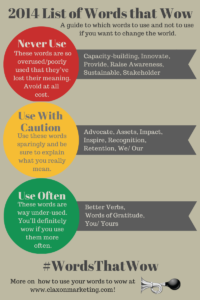 [This is part of our #WordsThatWow series. We covered which words to avoid, and have been looking at which ones to use with caution, including inspire, impact, and advocate. In this post, we look at another word to use cautiously–retention.]
[This is part of our #WordsThatWow series. We covered which words to avoid, and have been looking at which ones to use with caution, including inspire, impact, and advocate. In this post, we look at another word to use cautiously–retention.]
Retention has been on my radar as a word I worry about ever since talking to Super Smartie Peter Drury a few years ago about his ‘Beyond Cash Fundraising Dashboard‘ (a FREE tool that you can and should download).
Then recently, the ever-wise and insightful Tom Ahern (who has a FREE newsletter that you should absolutely subscribe to if you don’t already) asked if we should be focused on retaining or renewing. Good question, Tom!
In the nonprofit world, we often couple the word ‘retention’ with ‘rate’ to get the all-important ‘retention rate’. A higher rate means more donors are giving a second, third, fourth gift to your organization. This is a good thing. We want more donors giving year after year. The concept isn’t the issue.
The issue is the word ‘retention’ and what it means for the donor experience. When you give to a charity, do you sit back and say to yourself, “Dang, I really hope they retain me.”? Of course you don’t. Retain means to “keep in one’s possession” or “to be able to hold or contain”. Like a plant retains water. Could be totally wrong on this one, but going to go out on a limb and say most donors don’t want to be thought of like house plants.
Tom Ahern’s suggestion, which is thanks to Penny Harris at Renewable Philanthropy, is to focus on renewal instead of retention. Why? Because renewal “puts the focus on the donor’s desire to continue finding meaning through your mission”. That sounds way better than being possessed or contained, now doesn’t it?
As with all the words in the ‘Use with Caution’ category, I’m not saying never, ever use retention again. I’m simply suggesting that you pay attention to when you use it, what it means and, importantly, how the word might translate into a sub-par, donor-as-house-plant experience for your dear donors.
Say it with me: “Friends don’t let friends treat donors like house plants.”

